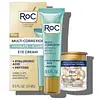What's inside
What's inside
 Key Ingredients
Key Ingredients

 Benefits
Benefits

 Concerns
Concerns

 Ingredients Side-by-side
Ingredients Side-by-side

Water
Skin ConditioningGlycerin
HumectantLactose
HumectantC12-15 Alkyl Benzoate
AntimicrobialCetearyl Ethylhexanoate
EmollientPEG-100 Stearate
Glyceryl Stearate
EmollientPEG-8
HumectantStearyl Alcohol
EmollientTromethamine
BufferingPanthenol
Skin ConditioningCarbomer
Emulsion StabilisingIsopropyl Myristate
EmollientMethylparaben
PreservativeDisodium EDTA
BHT
AntioxidantPropylparaben
PreservativeMagnesium Aspartate
Skin ConditioningZinc Gluconate
Skin ConditioningChlorhexidine Digluconate
AntimicrobialRetinol
Skin ConditioningPolysorbate 20
EmulsifyingCopper Gluconate
Skin ConditioningWater, Glycerin, Lactose, C12-15 Alkyl Benzoate, Cetearyl Ethylhexanoate, PEG-100 Stearate, Glyceryl Stearate, PEG-8, Stearyl Alcohol, Tromethamine, Panthenol, Carbomer, Isopropyl Myristate, Methylparaben, Disodium EDTA, BHT, Propylparaben, Magnesium Aspartate, Zinc Gluconate, Chlorhexidine Digluconate, Retinol, Polysorbate 20, Copper Gluconate
Water
Skin ConditioningGlycerin
HumectantDimethicone
EmollientPropanediol
SolventCetyl PEG/PPG-10/1 Dimethicone
EmulsifyingSodium Hyaluronate
HumectantBis-PEG/PPG-14/14 Dimethicone
EmollientButylene Glycol
HumectantCaffeine
Skin ConditioningBiotin
AntiseborrhoeicPalmitoyl Tetrapeptide-7
Skin ConditioningMagnesium Aspartate
Skin ConditioningPalmitoyl Tripeptide-1
Skin ConditioningZinc Gluconate
Skin ConditioningChrysin
Skin ConditioningN-Hydroxysuccinimide
Skin ConditioningCopper Gluconate
Skin ConditioningSteareth-20
CleansingMethyl Methacrylate/Glycol Dimethacrylate Crosspolymer
Chlorhexidine Digluconate
AntimicrobialCaprylyl Glycol
EmollientChlorphenesin
AntimicrobialPotassium Sorbate
PreservativePhenoxyethanol
PreservativeSodium Chloride
MaskingSodium Citrate
BufferingCitric Acid
BufferingWater, Glycerin, Dimethicone, Propanediol, Cetyl PEG/PPG-10/1 Dimethicone, Sodium Hyaluronate, Bis-PEG/PPG-14/14 Dimethicone, Butylene Glycol, Caffeine, Biotin, Palmitoyl Tetrapeptide-7, Magnesium Aspartate, Palmitoyl Tripeptide-1, Zinc Gluconate, Chrysin, N-Hydroxysuccinimide, Copper Gluconate, Steareth-20, Methyl Methacrylate/Glycol Dimethacrylate Crosspolymer, Chlorhexidine Digluconate, Caprylyl Glycol, Chlorphenesin, Potassium Sorbate, Phenoxyethanol, Sodium Chloride, Sodium Citrate, Citric Acid
Ingredients Explained
These ingredients are found in both products.
Ingredients higher up in an ingredient list are typically present in a larger amount.
Chlorhexidine Digluconate is a preservative.
This ingredient is a copper salt known for its wound healing properties.
Our bodies use copper to help stabilize our skin's collagen and elastin. Its also an essential for superoxide dismutase, an enzyme with strong antioxidant properties.
Copper has wound healing properties due to its role in creating new blood vessels and tissue repair.
Learn more about Copper GluconateGlycerin is already naturally found in your skin. It helps moisturize and protect your skin.
A study from 2016 found glycerin to be more effective as a humectant than AHAs and hyaluronic acid.
As a humectant, it helps the skin stay hydrated by pulling moisture to your skin. The low molecular weight of glycerin allows it to pull moisture into the deeper layers of your skin.
Hydrated skin improves your skin barrier; Your skin barrier helps protect against irritants and bacteria.
Glycerin has also been found to have antimicrobial and antiviral properties. Due to these properties, glycerin is often used in wound and burn treatments.
In cosmetics, glycerin is usually derived from plants such as soybean or palm. However, it can also be sourced from animals, such as tallow or animal fat.
This ingredient is organic, colorless, odorless, and non-toxic.
Glycerin is the name for this ingredient in American English. British English uses Glycerol/Glycerine.
Learn more about GlycerinWe don't have a description for Magnesium Aspartate yet.
Water. It's the most common cosmetic ingredient of all. You'll usually see it at the top of ingredient lists, meaning that it makes up the largest part of the product.
So why is it so popular? Water most often acts as a solvent - this means that it helps dissolve other ingredients into the formulation.
You'll also recognize water as that liquid we all need to stay alive. If you see this, drink a glass of water. Stay hydrated!
Learn more about WaterZinc gluconate has antibacterial and wound healing properties. It is particularly effective against fighting inflammatory acne.
This ingredient is the zinc salt of the PHA gluconic acid. PHAs are gentle cousins to AHAs.